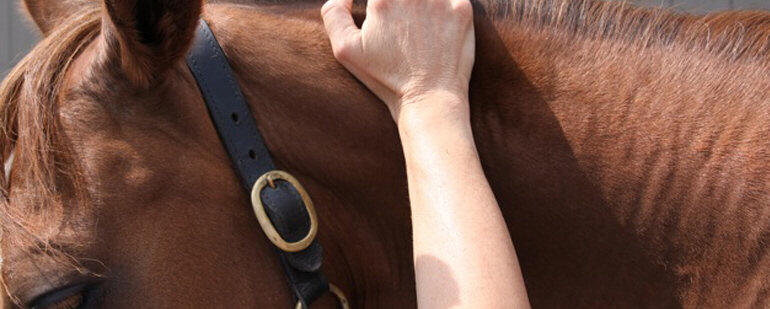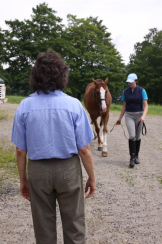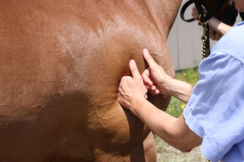|
 |
CASE STUDY:Refusing to pick up the correct lead at the canter. Shortened stride in front.Presenting Problem:
I reassured her that this is a common muscular problem and if it was simple muscle tightness, I would be able to restore the motion immediately. . Problem Solving: Since I was evaluating muscle function, I asked my client to lead the horse at the walk away from me and then toward me in a straight line. I get the best view of muscle function at the walk. The horse was more labored and shorter in his left shoulder and was also shorter in the right hind. When I say labored, I mean that it appeared harder for the horse to bring his left shoulder forward, resulting in a shortened stride in the left front leg. I assumed that the right hind shortness was compensatory for the left shoulder. Since the dynamics of motion occur on a diagonal, the left shoulder and right hind would be the effected diagonal pair. I love my job because it requires a bit of detective work in conjunction with science and art. In order to get to the bottom of the problem I had to think about which muscle or muscles were not releasing for the horse to refuse to pick up the left lead. When a muscle is tight, it does not release or “let go” for the opposite motion to occur. Think of a person with a stiff neck. If the neck is very tight on the right side, the person finds it difficult to turn their head and neck to the left. Therefore the muscle on the right side of the neck is not letting go, or releasing, to allow for the head and neck to move to the left. In the new horse’s situation, he was able to bring his left leg and shoulder back freely, but when he wanted to bring the shoulder and leg forward, he seemed labored and short. I strongly suspected the triceps muscle. The triceps muscle is comprised of three muscles. The long head, the short head, and the medial head (medial head is on the inside of the shoulder ). Basically they extend the elbow, and flex the shoulder, which brings the shoulder and front leg back toward the tail. If the triceps were tight, then the muscle may not be letting go, or releasing to extend the shoulder by bringing the shoulder and leg forward (toward the head). I determined it was the tricep through palpation. I could feel a very hardened, board like left tricep muscle. It did not give to my hand nor did it feel flexible. I also felt the right gluteal muscle in the hind end, and that muscle felt tight as well. Solution: After determining the tricep was tight and
probably responsible for refusing to pick up the correct lead,I started
using one of the techniques of the Wilson Meagher Method.
Follow-Up: I suggested my client ride the horse after my work. The exercise becomes part of the treatment. This is the original sportsmassage as created by Jack Meagher. It was intended to prepare the animal for use. Therefore exercise further lengthens the muscle fibers after the application of the sportsmassage techniques. Before riding the horse, I asked the client to jog the horse in hand, in a straight line away from me and then back toward me. I wanted to be certain the muscle tightness was not secondary or protecting something deeper. The horse trotted out sound and look even in his stride. He was no longer short in the left front. I then asked the client to ride the horse at the canter in a connected long and low frame so that the horse was balanced from back to front. The canter is the most concerted exercise at lengthening all of the major muscle groups. The client couldn’t wait to see if the horse would pick up the left lead. She asked if I would wait to see her ride him. I was happy to wait and saw that when she rode him, he picked up both leads with ease. The motion problem caused by simple muscle tightness was solved! Cause: Every problem has a cause. It was important to try and figure out what caused the shoulder to be tight. Sometimes the cause is not that easy to find, but in this case it was. My client just bought the horse three weeks prior to me seeing him. She thought she would get to know him for the first two weeks by lunging him in a round pen. That sounded like a good idea until she told me she basically only had him travel to the right on the circle. I didn’t ask her why only to the right. Anyway, because he only traveled to the right at the walk, trot and canter, his left shoulder had to stretch on the circle to the right. Muscles tighten in a stretch position. Since the horse was in an overstretch going only to the right, the tricep tightened and resulted in the motion problem. Lesson: Always vary the work!
|
 |


 I
received a call from a very worried client. She just purchased her new
horse 3 weeks ago and recently, she was unable to get her horse to pick
up the left lead at the canter. As a result, the horse would not do a
proper lead change. I asked if her horse was lame. She didn’t think he
was weight bearing lame. Therefore she didn’t call a vet first. She
wanted to rule out simple muscle tightness as the reason for the new
problem. I appreciated her worry since she just purchased the horse and
she was fearful that there might be a deeper problem that was not picked
up during the pre purchase vetting. I thought it might be kind to inject
a bit of humor to try to calm her nerves, so I told her my father’s old
saying: “Worrying is using your imagination to create what you don’t
want”!
I
received a call from a very worried client. She just purchased her new
horse 3 weeks ago and recently, she was unable to get her horse to pick
up the left lead at the canter. As a result, the horse would not do a
proper lead change. I asked if her horse was lame. She didn’t think he
was weight bearing lame. Therefore she didn’t call a vet first. She
wanted to rule out simple muscle tightness as the reason for the new
problem. I appreciated her worry since she just purchased the horse and
she was fearful that there might be a deeper problem that was not picked
up during the pre purchase vetting. I thought it might be kind to inject
a bit of humor to try to calm her nerves, so I told her my father’s old
saying: “Worrying is using your imagination to create what you don’t
want”!  The
first technique I used was compressions. Compressions are a rhythmical
pumping action, using the heel of your hand or with two loosely held
fists. If using your fists, make sure to use the back of your fingers
and not the knuckles to create a kneading type movement. It can also be
used with two hands, similar to cardio pulmonary resuscitation. (CPR)
The hand and arm must be soft and not rigid to be effective. I used
compressions over the entire muscle and did circular compressions on the
small, medial tricep above the elbow on the inside of the shoulder.
After the compressions, which separate the muscle fibers allowing for
more blood flow, I used direct pressure and cross fiber friction at the
muscle tendon junctions of the tricep. The muscle loosened easily and I
then worked on the entire horse, focusing on the right gluteal muscle
that tightened in relation to the left shoulder. Always work on the
entire horse, The body is a unit and it must function like a unit. If
you were to work on just one area, then the body is likely to be out of
balance because one area may be loose and another area may remain tight.
The
first technique I used was compressions. Compressions are a rhythmical
pumping action, using the heel of your hand or with two loosely held
fists. If using your fists, make sure to use the back of your fingers
and not the knuckles to create a kneading type movement. It can also be
used with two hands, similar to cardio pulmonary resuscitation. (CPR)
The hand and arm must be soft and not rigid to be effective. I used
compressions over the entire muscle and did circular compressions on the
small, medial tricep above the elbow on the inside of the shoulder.
After the compressions, which separate the muscle fibers allowing for
more blood flow, I used direct pressure and cross fiber friction at the
muscle tendon junctions of the tricep. The muscle loosened easily and I
then worked on the entire horse, focusing on the right gluteal muscle
that tightened in relation to the left shoulder. Always work on the
entire horse, The body is a unit and it must function like a unit. If
you were to work on just one area, then the body is likely to be out of
balance because one area may be loose and another area may remain tight.